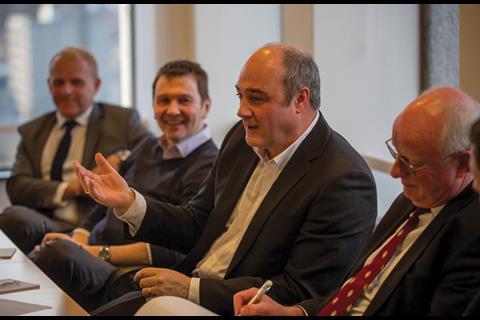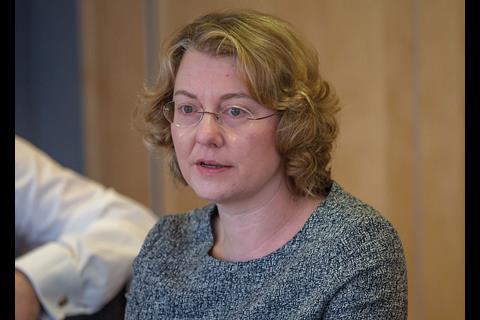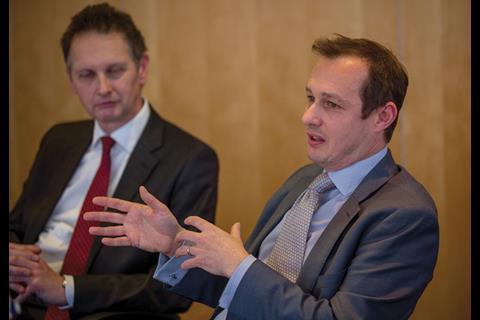How should law firms grow? Are mergers best or could they even issue 10-year bonds? Eduardo Reyes reports from the Gazette’s latest roundtable in Bristol.
Once upon a time there was no question where Bristol’s legal centre was located – the elegant, 18th century Queen Square and the streets thereabouts. Some firms remain, and perhaps the local legal community’s ‘soul’ still resides here.
But many of the city’s firms have outgrown the former mansion houses that line the square, building or refurbishing much larger office blocks to the east. Some have moved two or three times in the last 20 years.
This Gazette roundtable has come to Bristol to talk about growth. Most of those attending are based in the city, though some are also part of national and international firms. All have clients based outside the south-west; and all have a story to tell. But first, those present address the question: why grow at all?
Simon Holdsworth is managing partner of Thrings, a firm with offices in Bath, Bristol, London and Swindon. He suggests that news coverage of consolidation and ever-present (and popular) league tables in trade media contribute to a mindset that growth is a must.
‘Does that drive some of our strategic thinking?’ Holdsworth asks. ‘We’re told that we’re not big enough and therefore we rush to get bigger. Now we’re post-recession, there is that sense that there is more of a rush to expand in terms of turnover.’
That is the case even though all pay lip service to the notion that growth is about improving profitability and not just turnover, in accordance with the dictum: ‘Revenue is vanity, profit is sanity’.
TLT managing partner David Pester suggests the right questions for a firm to ask are rather: ‘What do you need to be relevant? What’s the best way to achieve sustainability and competiveness around scale?’ All firms, Pester says, ‘respond to the buying behaviour’ of clients, but ‘investment capacity’ is a key consideration.
‘If you’re smaller, you can be niche and you can be very successful. But if you want to sustain a business, you have to have a very clear investment plan. I think what has been going on in the market is as much about sustainability, as it is about pure growth.’
‘I don’t subscribe to being big for big’s sake,’ comments Nathan Peacey, head of markets in Foot Anstey’s management team. ‘But I do think there is an issue regarding economies of scale. There’s an inevitable drive for us to deliver value and efficiencies, and that is a function of scale too.’
When scale means a greater range of expertise, it can be crucial in winning business. For example Simon Mason, executive partner at DWF, says insurer clients conducting panel reviews increasingly asked his firm whether it could add ‘more to the party’ in other insurance lines. Strategic hires and merging with other firms have allowed DWF to meet that need.
Of course growth – or contraction – can also be contingent on shifts in public policy, says Steven Greenwood, Stone King’s managing partner for Bath. The expansion of the government’s academies programme has driven huge growth in his firm’s education practice. In the past five years, he notes, the department has grown by 400%, leading the firm to plan a further office, in Leeds, that will open shortly.
Jeremy Davy, managing partner of Gordon Dadds’ Cardiff and Bristol offices, notes that one motivation here relates to the important consideration of recruitment: ‘If you’re looking to bring people into the business, then it helps to provide a story of a growing, developing firm.’
Tony Cherry, DAC Beachcroft’s regional senior partner for Bristol, cautions that although growth is a common preoccupation, the market itself is growing modestly if at all. ‘Absent the total size of the market increasing, mustn’t this mean that we’re all planning to grow at somebody else’s expense?’ he asks. ‘That is fine, but ultimately what that amounts to is redistribution in terms of the structure of the profession.’
For Emma Costin however, head of personal injury at Simpson Millar, there is a large latent market that offers real opportunities. Her firm employs a dual strategy: ‘Growth is about building market share in relation to competitors, but also trying to engage directly with consumers who otherwise wouldn’t have consulted a lawyer.’
Given that margins in consumer claims are challenging, targeting that market has required investment and growth, she adds. This is an allusion to Simpson Millar’s merger with Manchester firm Colemans-ctts, which ‘had a class-leading volume processing centre, which we didn’t’. For this reason, merger was ‘a massive strategic decision’, Costin explains.
Gordon Dadds, Davy reflects, has been able to grow by strategic add-ons arising from the travails of others in its market. ‘We’ve acquired three firms out of administration, which has enabled us to expand our expertise and our client base quickly and efficiently, while maintaining an acceptable margin.’
Even when growth results from a sustained increase in client demand, it still needs to be financed ‘up front’. Mergers can bring additional costs arising from integration, new offices and staff and partner hires. Firms represented at the roundtable deploy various financing models.
TLT uses traditional sources of finance, but Pester notes that the investment balance has shifted since the firm was created in 2000 from the merger of Lawrence Tucketts and Trumps. ‘Our model is a fairly straightforward one,’ he explains. ‘It’s a combination of some bank debt, some asset finance, [but] mostly partner capital. When we were in our first phase of development, we probably had slightly higher bank debt and lower levels of partner capital. We’ve completely reversed that.’
Cherry says market conditions presently militate against seeking external finance. ‘You don’t have to be a genius to see that, in the light of recent developments around one or two other players in the market, that’s probably not a realistic option at the moment.
‘The wisdom of looking at a balance between conventional debt and conventional equity is reinforced by this,’ he adds, placing an emphasis on ‘keeping debt under control’.
Following the acquisition of its own law firm in 2013, legal expenses insurer DAS was responsible for one of the market’s earliest alternative business structures. It now practises as DAS Law.
At the table
Julian Kinsey, Bond Dickinson: Emma Costin, Simpson Millar; Eduardo Reyes, Law Society Gazette; David Pester, TLT; James Christacos, DAS Law; Nathan Peacey, Foot Anstey; Matthew Still, The Law Society; Stephen Moore, Ashfords; Simon Holdsworth, Thrings; Steven Greenwood, Stone King; John Moriarty, Bristol Law Society; Jeremy Davy, Gordon Dadds; Tony Cherry, DAC Beachcroft; Simon Mason, DWF
The firm’s managing director, James Christacos, stresses that its business model is not driven by a perennial search for external funding. Upon foundation of the ABS, he notes, ‘predominantly, we were there to service the claims and needs that were coming out of DAS’s insurance business’. Now, he says, while that work has remained steady, ‘most growth has been in employment work, property and contract litigation’.
Pester, a one-time corporate finance lawyer, believes that in addition to partner capital and bank debt, other stable sources of finance could evolve. ‘A bond structure could be really interesting for ten-year money for some law firms; it might be slightly more expensive, but nonetheless would probably be more stable,’ he suggests.
Under such a scheme, provided it could be designed to comply with the necessary regulations, a firm could issue bonds to raise funds – likely sold through a broker or dealer. The face value of the bond would, of course, be redeemed on the date it matured, having been sold below face value when issued. Bonds would probably be dearer than other forms of finance, but would obviate the need to offer an equity stake in the business – and as a form of finance could not affect the stability of firm finances until they matured.
John Moriarty, president of Bristol Law Society, returns to the need for law firms to differentiate themselves from competitors where the market is mature or even saturated. He observes: ‘Each of the largest firms [in Bristol] has gone down a slightly different route. They were probably competing more against each other 10 to 15 years ago than they are now.
‘They are still competing,’ he adds, ‘but they’ve all got their own niche. They are differentiated.’
Julian Kinsey, head of Bond Dickinson’s Bristol office and the firm’s national banking team, points to the airline industry for a comparison: ‘The underlying service – flying you from A to B – that’s the same, isn’t it?’
Likewise for law firms, the underlying service will be ‘providing a will, or conveyance, or flotation, or management buy-out’. So ‘if it’s an MBO, there are any number of firms in this city, or any other city, which can provide the service. The client will take that as given. Above and beyond that, for you to obtain the mandate you’ve got to offer something different’.
DWF’s Mason points to the benefits of diversification to develop a broader professional services business, a model followed by the big accountancy firms.
There is, he explains, a consultancy arm to the firm’s business. ‘We have transformed our business model to give clients greater flexibility,’ he says. ‘Expanding our services to include a consultancy arm, flexible resource capability that clients can draw on and a legal tech business enables us to deliver a different, boarder offering which, we believe, differentiates us in the market.’
He adds: ‘At the moment, the law firm is significantly bigger than the other parts of that business, but I think we’d like to see that changing… We’d like to see the consultancy business growing faster.’
Peacey frames the issue rather differently: ‘There are too many law firms in the commercial space which are too focused on themselves and not their clients,’ he argues. ‘To me, differentiation is about having proper conversations with clients – hearing what is important to them and what success looks like. Then you can work with them on a value proposition.’
Thus, he adds: ‘The route to differentiation isn’t necessarily in your whole market position or a range of products. I think it’s around that deep and meaningful relationship with clients.’
Location
The relationship between clients, location and the sustainability of legal practices is an important one to understand, and all around the table have had cause to consider it carefully.
Much of the work completed in regional offices does not, after all, originate in that region. Gordon Dadds’ business model is instructive here. Davy characterises the firm as ‘a London firm’, explaining: ‘It’s about growing specifically in London and supporting this from Cardiff… we want to become a bigger organisation in the London marketplace, and we want a business model where we make an acceptable margin in that marketplace.’
The regional office, unusually for a firm in the mid-market, exists for the same reason as much larger firms’ better-known ‘nearshoring’ operations. It was established for back-office work and legal advice was an add-on that is now growing quickly. ‘The fastest growing team in Cardiff at the moment is the property team, but they’re building relationships with the property guys in London,’ he adds.
The importance of London is also referenced by DAC Beachcroft’s Cherry: ‘It feeds into this question about how much location matters. And I think the answer has changed.’
At one time, he says, ‘[DAC Beachcroft] had lots of locations, because local markets used to demand it’. But now many locations outside the capital feed off ‘the supply of services in the London market’ as well as local work.
Cherry adds: ‘Most people doing transactional work in Bristol see themselves as working in Bristol and London.’
People
A critical mass of sizeable and accomplished law firms in a major city like Bristol also helps to attract talent from outside the region; people without whom firms could not grow much if at all. Yet there is a change in what lawyers at an early stage in their careers want; and also in what legal businesses are able to offer them in terms of progression and rewards.
As Davy puts it: ‘A whole generation of lawyers is starting to think differently to previous generations in terms of career goals. The “traditional” business model may not necessarily meet the needs of that generation.’
‘When I qualified in the late ’90s, my objective was to be a partner of a law firm, but I’m not sure that’s necessarily the obvious [goal] nowadays. It is the case for some, but not all – it’s reducing.’
Much-trumpeted new business models should provide a wider range of opportunities to professionals to progress in their careers and to enjoy the rewards of that progress. But DAS’s Christacos
notes that ABSs need to work much harder to explain what a career in an ABS will (and will not) entail.
Christacos has encountered the assumption that DAS Law is a ‘typical law-insurance ABS that’s only doing claims work’ for an insurance company, ‘which we’re absolutely not’. His current recruitment focus is dispelling that myth to bring ‘mid-level’ talent in to the business that will allow it to grow further.
The demand for flexible working, or at least a degree of greater flexibility, is now an established feature of the local market, those present agree. Stone King’s Greenwood says: ‘We’re seeing an increasing number of applications for flexible working, and working from home.’ This is ‘all good’, he adds, but requires careful team management: ‘When is the team going to be together? How are we going to supervise? How are we going to train people if lots of people are out and about all the time?
‘I think we have to offer [flexibility] to attract people, but it needs a different sort of management to get people to focus on this.’
The future
The discussion closes with talk of how those present are planning to expand their own businesses. Kinsey relates that more than two years into the merger of Bond Pearce and Dickinson Dees, integration is ‘largely complete’. That means the combined firm is focusing on the next part of its growth strategy - taking turnover from £110m to £200m.
Pester says following two years of heavy investment, TLT is looking to realise a return on that investment.
Christacos’s DAS Law is two years in to a programme to ‘re-engineer’ the firm’s processes to be better aligned with the ‘customer journey’ – a process that he says will run for another two years.
For Greenwood’s Stone King, a new Leeds office reflects a commitment to growing education and charities work in particular. And Ashfords’ Bristol office head Stephen Moore is betting on more growth from ‘non-traditional legal services’, observing: ‘Year on year we do look for double-digit growth, and we should be on target for that. Bristol is a heavily lawyered market,’ he adds, ‘but I don’t think that should stop us looking for local growth and national growth as well.’
For DWF, Mason notes that after a busy period for acquisitions, growth will most likely come through lateral hires and organic development; while DAC Beachcroft’s Cherry expects close attention to productivity to be his firm’s main preoccupation.
The temptation for firms to concentrate on their in-trays to the exclusion of longer-term growth strategy is strong, especially given greater buoyancy in the civil legal services market. But, Pester reflects, there remain compelling reasons to pay attention to remaining ‘match-fit’.
He says legal businesses should be equipped for models that require a ‘complete correction in [our] reward strategy and a complete correction in the ownership [structure]’. The legal sector, he adds, is ‘in a phase of very gradual change’, but advises: ‘You’re going to need to have a very different kind of business to operate in what could be a smaller, flatter market.’
- This roundtable was kindly hosted by TLT

































1 Reader's comment